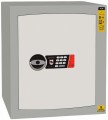Capacity
The volume of the interior space of the safe. Usually this parameter is indicated taking into account the safe-in-safe and other additional internal compartments. The amount of content that can be placed inside directly depends on the volume; on the other hand, it affects the external dimensions and weight of the storage.
Burglary resistance class
A parameter that characterizes the degree of resistance of the safe to burglary - that is, direct damage to the door or wall in order to gain access to the contents.
Safes manufactured in different countries have different certifications for burglary resistance. So, in accordance with the Ukrainian standard DSTU EN 1143-1:2019, there are 13 classes of burglary resistance of safes. The same number of gradations are available in the ECB-S marking, which is assigned to safes by the European Security Systems Association (ESSA). The classification covers not only resistance to damage, but also the tear resistance of an anchored safe, and bracing is required to classify safes weighing less than a one ton (see below). Pull-off resistance is simply determined by the force required to remove it from the mount; this force is indicated in newtons, 10 N corresponds approximately to a force of 1 kg. To assess the resistance to damage there are so-called resistance units (Ru) - breaking time multiplied by the coefficient of resistance of the tool used. For each type of tool, the coefficients are different - for example, from 1 to 5 for a chisel, 5 for an electric drill, etc. For example, if a control sample of a safe of a certain model was cracked by a drill in 4 minutes, then its resistance to cracking is 20 Ru. Note that the check is carried out in two versions - for full and partial access to the contents of the safe; when assigning a class, both results are taken into accou
...nt, they are often written as "partial/full resistance", for example 120/180.
Now there are safes on the market with the following burglary resistance classes: H0 class, Class 0, Class I, Class II< /a>, Class III. Safes with a higher burglar resistance class (Class IV, V class, Class VI, Class VII, Class VIII) are much less common.
Detailed data for each class can be found directly in the regulatory documentation. For example, here are the first three classes:
— H0 class (“below zero”). Minimum burglary resistance class to be certified. Requires a resistance of at least 15 Ru for both access options, and a pull force of at least 50 kN.
- 0 class. Safes with a resistance of at least 30/30 Ru and a pull force of 50 kN or more.
- I class. Models with a resistance of at least 50/30 Ru and a breakout force of 50 kN. The minimum class for safes classified in our catalog as burglar-resistant (see "Product Type").
There are also more burglary-resistant models on the market - up to class VIII.
The burglary resistance class is confirmed by a certificate issued by state bodies for technical regulation and standardization. The validity period of the certificate is limited, and usually it is much less than the time during which this or that model is produced. Therefore, safes are regularly re-certified. For a number of reasons, new results may differ from previous results and correspond to a different resistance class than that recorded in the outdated certificate. Therefore, over time, the class of the same model may change even if the quality of the safes themselves remains unchanged.Lock model
This paragraph indicates the manufacturer of the safe lock.
Door thickness
This parameter means the actual thickness of the safe door; do not confuse it with wall thickness, see below. This dimension is measured excluding the lock and other protruding parts. It is one of the main factors determining the reliability and burglary resistance of a safe (see “Burglary resistance class”). In addition, regulatory documents may consist of direct requirements for certain categories of safes (for example, gun safes, "bank", etc.), including the minimum permissible door thickness.
Note that a thick door is especially important for embedded models (see "Product Type") — after all, in the normal position from the sides and back, the storage is protected by the wall it is mounted into, and the door remains outside.
Body walls thickness
The thickness of the metal sheet used to make the sides and back of the safe body. Do not confuse this parameter with the total body thickness (see above), these values may not match. For example, if the safe has a filler layer between two sheets of metal (which is typical for fireproof models, see “Product Type”), then the total thickness will correspond to the total thickness of all materials, and the wall thickness will correspond to the dimensions of one of the metal sheets. Since that metal plays the main role in burglary protection (fillers have a different purpose), the reliability of the safe largely depends on the thickness of the walls.
Weight
The total weight of the empty safe. Unlike many other products, for safes, heavy weight is usually more of an advantage than a disadvantage: the heavier the safe, the more difficult it is to steal it entirely for later opening in a safe place. The only exceptions are portable and automotive models (see "Product Type") — in their case, theft prevention is ensured primarily by fastening, and in the first case, the product, by definition, must be suitable for carrying in hands.

